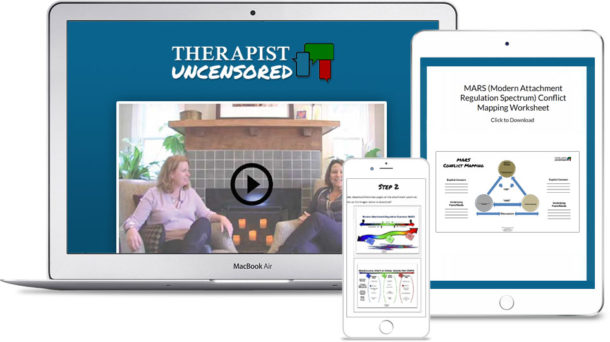Podcast: Play in new window | Download (Duration: 30:43 — 70.4MB)
Subscribe: Apple Podcasts | Spotify | Amazon Music
The science of relaxing into love, this episode continues the exploration of Polyvagal Theory, one of the most important theories of our generation, especially when it comes to trauma and psychological treatment.
Join Sue Marriott and Ann Kelley as they continue to break down and bring Polyvagal Theory to life. Through discussion and real-life examples of what happens when our bodies experience threat, you will learn how to recognize when you or your loved one is experiencing an unconscious physiological threat response as well as some practical self-regulation skills to move back into safety. Additionally, we will begin unfolding how powerful relationships are in helping us establish, maintain and return to a physiological state of safety. It’s true, love really is a drug!
Why are we so jazzed about Polyvagal Theory (PVT)?
- PVT looks at the body related to attachment, related to getting close to one another, and to co-regulation and ties it all together!
What’s PVT all about?
- PVT is an evolutionarily based theory that explains how our bodies sense danger and threat and also how we respond.
- It helps us to understand what is going on physiologically during these times, so we can learn to recognize our bodies’ signals and utilize skills to regulate our nervous system.
Polyvagal Theory Breakdown
The bottom line is are we safe or are we in danger?
Neuroception:
Our brains are always scanning for info from the environment that regulates whether we feel safe or not safe. It is spontaneous and completely outside of our awareness.
Old View:
- Only Fight or Flight Response Systems, but that’s outdated.
Polyvagal View:
- We not only have a Fight or Flight Response, we also have a Freeze Response.
The Systems and the Vagus Nerve
Autonomic Nervous System –
- Autonomic=Automatic – all the things our bodies do for us without thinking
- Examples: blinking, digestion, etc…
- Breathing is the only autonomic process we can manipulate consciously
Parasympathetic
- Para=Paralyzed
- This is the brake.
Sympathetic
- Energizing
- Where “Fight and Flight” are
- Prehistoric example (Old View):
- being attacked by a saber tooth tiger, response will be to run from it or fight it, literally.
- Everyday example:
- A mad spouse, angry boss, disapproving parent
- Fight=defensiveness, blame, etc.
- Flight=withdrawing, physically leaving a party, stonewalling
The Vagus Nerve
- Largest nerve in the body
- All mammals and vertebrates have it, some versions of it in fish
- Runs throughout our entire body
- Information Freeway – carries information from scans of the environment to the brain
Our Brains: Safety vs Danger
Safety:
- This is the Social Engagement System (The Green Zone)
- When we are safe, the lights are on all the way to the top of our minds.
- We are our very best selves.
- Hearts are open
- Whole neuro psychological, the biological system is signaling safety: the heart rate slows, breath is steady, able to digest food, make eye contact, have movement in our face so other people can read us, inner ear relaxes, ears relaxes enabling us to pick up human voice very, very well.
Danger:
- When in danger, our brains work in reverse order.
- breathing quickens and is shallow, heart rate increases, non-vital body functions are shut down, Inner ear constricts because it listening for high tones and low tones – listening for predators, oxygen level decreases, stress hormones (cortisol, norepinephrine, and adrenaline) are dumped into system.
Neural WiFi:
- Our unconscious neurological states of feeling safe or feeling threatened translate to the people we interact with, even through the phone.
- Example: Sue & Ann’s phone conversation
Bottom Up:
- Vagus nerve: picks info up from our body bottom and carries it up to the brain
- Brain:
- Safety: top of the mind
- Can think and reflect down, think about what’s happening and even learn new things
- Danger: bottom of the mind
- top begins to go offline, the more danger we feel, the more and more primitive we get
- choices constrict, info coming in constricts
The Systems:
Ventral Vagal:
- Social engagement system
- Sympathetic
- example: parent and child chest to chest or lovers chest to chest – they make a “V”
Dorsal Vagal:
- Associated with trauma and life threat
- example: partners laying back to back, dorsal fin on the back of a shark
- 2 types of Dorsal Vagal responses
- Involuntary shutdown
- often misinterpreted as an intentional cease in response
- what actually happens: system has blown a fule, aren’t able to process language as easily or say a lot, physical body collapse, going flat, more immobile
- Increased Agression:
- happens depending on history
- example: seeing someone going flat and immobile is interpreted as threatening because it signals system that they are going away creates a feeling of overwhelm and feeling of aggression
Dorsal Vagal:Dropping into Parasympathetic
- associated with dissociation, feigning death, about life threat
- full parasympathetic shutdown
- even being mad and fighting is better than this
- Stonewalling vs Dorsal Vagal
- Complete collapse
- Not voluntary, but can be worked on
- This reaction indicative of unresolved trauma, trauma is hitting you and that is where this response comes from
Example: opossum playing dead
Trauma is not psychological.
It is physiological.
Discussion:
- The importance of breathing:
- Real life example: Active shooter drills in schools – talk about different reactions and teaching about the importance of breathing to take us out of the Freeze response
SO, how do you activate more social engagement?
We are social beings, we are social animals. So we are wired for connection. We truly need it. It has to do with proximity; it has to do with connection. So those are the things that we want to steer towards. In social engagement, there this neuropeptide called oxytocin that gets activated. When oxytocin gets activated, it’s all the good stuff that happens. Basically, it’s Gabba and a whole bunch of really wonderful feel, good chemicals and hormones.
Stay tuned for the next episode where we talk about inducing oxytocin in a very particular way. You’re going to love it!
Who doesn’t love special offers?
Gain access to private, more in-depth episodes and exclusive content.
Become a Super Neuronerd, a Gold Neuronerd or an Out and Proud PLATINUM NEURONERD today! 🙂
Join our exclusive community of Therapist Uncensored Neuronerds for just $5 a month!
Help us create a ripple of security by sharing the science of relationships around the globe!
NEURONERDS UNITE! Click here to sign up.














